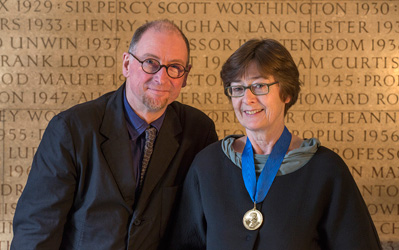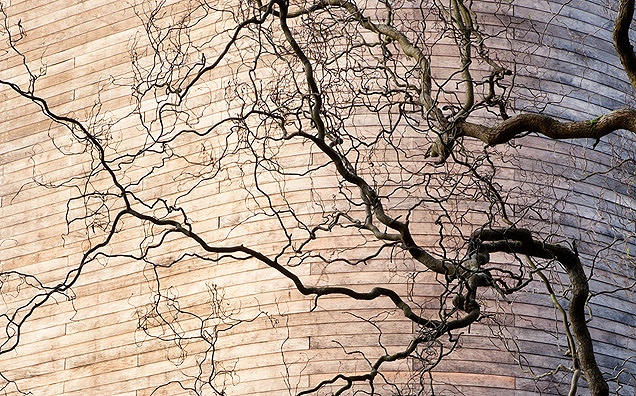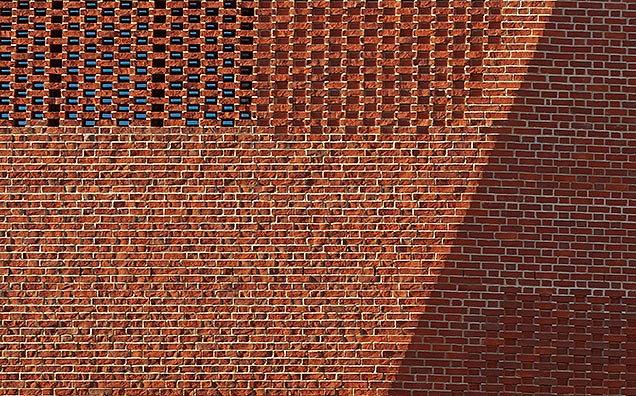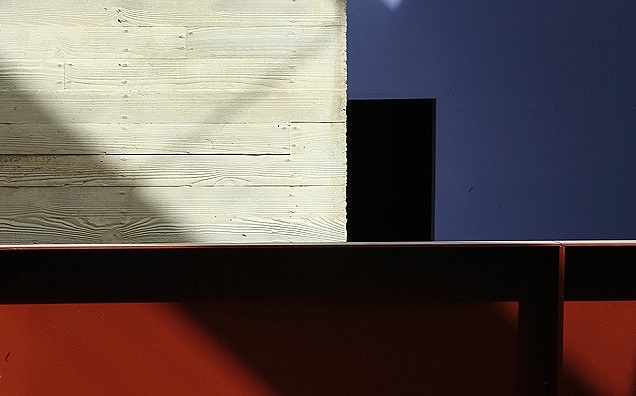Interview: Sheila O’Donnell & John Tuomey

Aaron interviewed Sheila O’Donnell & John Tuomey when they were in New Zealand recently – one week after they were awarded their RIBA Royal Gold Medal in recognition of their substantial contribution to international architecture.
AS: Can we start with some history? Some thoughts about your education and your early practice?
SO: We met in the University College Dublin School of Architecture where we were together in first year. I made a passing reference in the lecture today that the tutor we had in first year – Shane de Blacam – who’d just come back from working with Louis Kahn. We didn’t realise – because we were only first year students who knew nothing about architecture – but the stuff he was talking about was based upon Kahn’s theories. And actually it was a fantastic grounding for us in architecture in terms of the physicality and craft, and the meaning of architecture.
JT: He had just arrived back from Kahn’s office. We were the first students he met and he adopted us. He approached design from a very open ended point of view and made us look at everything we did from first principles. So we got this wonderful introduction but later years in the school were more disappointing. And then Sheila and I got together through meeting in the library trying to make our own education – we became kind of survivors. And then we eventually ended up living together in London.
SO: London was really important. It was the late 70s and there was a really lively discursive scene in London in architecture, around the AA and other groups. Peter Cook had a group called Artnet, which had lectures and meetings where everybody sat on deck chairs in funny spaces around London. So it was a really engaging period. The works of people like the Italian Rationalists were beginning to be talked about and it was the time just before postmodernism came in.
There was just a lot of energy – it was a very good time to be in London. John worked for Stirling all the time we were there. After two years working, I did the 2-year postgraduate course at the Royal College. Kenneth Frampton was teaching there and it was an interesting period for the course. It was full time, but I continued working a bit at Colquhoun & Miller. Then John went back to Ireland before I did and I took over his desk in Stirling’s office. So we both worked for Stirling, but not together.
JT: I think that’s why this whole RIBA gold medal business has gone so deep with us because we feel that we were schooled and conducted our apprenticeship in London, and that we get London. It’s in us – because we’ve worked there, we visit there, we’ve taught there, and yet somehow or other this unexpected gong comes right out of the London culture, but it is actually worldwide. And the reaction to it has been from around the world. People are saying that it is a statement in support of the type of practice we pursue, and which is pursued by people all around the world. And that’s from people we hardly know.

AS: Do you travel, present at conferences and teach widely?
JT: We’ve taught in Italy and taught in America, exhibited in Japan and all that, but it takes a big effort to come to a conference like this because it is not all within your control. The invitation to come here came a year ago and we said, “that’s interesting, we’ve never been there, let’s do it”. And then recently we were asked if we would accept the RIBA gold medal and the ceremony would be in the second week in February, and we said “Oh we can’t do that, because we’re going to New Zealand!”… so, luckily they agreed to move the ceremony forward by a week.
AS: You’ve spoken about the importance of London, but was leaving important as well?
SO: Yes, it was very important. It was at a stage where this postmodernism thing was getting to the point where it was starting to annoy us a bit. Even though I was working for Stirling, and Stirling was so important and a wonderful architect, I think some of the work he was starting to do was just drifting a little bit out of our reach of understanding.
It is incredible what a strong grip that wave of thinking had on people and it started from a really good thing that we should look at and be conscious of history. But it started to get like a catalogue, “I’ll have one of those and a bit of that and I’ll put this on here” etc. We thought this was all about what things look like. So we thought we’ll just go back to Ireland and kind of get back to basics.
When we came back we spent a lot of time looking at buildings that were either vernacular or old buildings to try and get away from the Tecton thing and to question why is this building the shape it is, why is it like this on the site? It was almost a conscious re-grounding in principles.
We had been told by a friend to go back and change the face of Irish architecture and we thought we were going to make a new Irish architecture. We spent a lot of time thinking about that by looking at all this old stuff. We were just realising that our subject was thinking about context and place in as wide a way as we could, and it just happens that Ireland was the place we were in, and that that same thinking could be applied anywhere.
We found ourselves in the funny position 10 years later when people would say “I don’t know if your work is as Irish as it should be – you came back here to do this and now you’re letting us all down by not doing it”. We said, “No, we have no responsibility to anyone else to be the most Irish thing that ever happened.”
AS: Was it that slowness at the beginning that was a good foundation for your learning?
JT: It very well might have been. A stony road prepares you to live on a meagre diet. But it also probably slows you down. You know what Sheila was saying about us driving down the back roads of Ireland trying to seek out the soul of Irish architecture, but what came out of it was this emphasis on close reading or close noticing, or just this feeling that our function is to read sense back into the situation that we find.
Those early years were quite frustrating, what we got out of it is that we must pay attention. That’s what we’re for – for reading it back until we can make sense of it.
AS: Which is back to first principles – and perhaps a reason to get away from someone is to avoid their shortcuts?
JT: Well, the reason to get away from Jim was this – a project would come into the office and he would set a small team to generate ideas for it. You would do a scheme in a morning, and probably another one in the afternoon. By the end of the week you’d have a number. You’d show him a few. He’d pick one. He would give it back to you to work on it or swap it around. So you got into the habit of doing quick schemes, and I think that’s not good. So it was fine for him. And we knew how to do it quickly, but there was a sense of “just hold on a minute, give me some headspace, let me think”. So in our own work we kind of pick our way more slowly.

AS: Is there conflict between the time-hungry demands that clients can have and your own demands for patient working?
JT: I would probably turn your elegant word ‘patience’ around into something much more blunt like ‘tenacity’. Most of these people aren’t asking us to be that patient. So maybe an architect has to have tenacity to the point of stupidity – you just hold on. Projects usually take a little longer than the client expects – they’re always asking how fast can you do this? But the people who delay the project are usually the client. I don’t know of any architect who has ever delayed any programme ever.
We do dwell on things. As soon as we’ve done something, it’s not finished. As soon as we’ve done the diagram, we do it again. Not another version, but honing it. We take a little bit off it each time. A lot of it is making something more like itself. That’s the question we ask more often than anything else: “is it more, or less, like itself? If I take this off, is it more like itself now?” You have to have a sense of what “itself” is, but the concept is clarified through the process, it doesn’t precede the process. That is why we don’t like competitions, because they ask you to jump, and we don’t like that.
SO: You kind of have to lay an egg in a competition – “there’s the answer.” This leaves out the client discussion bit.
JT: But that said, we’ve got all our work through competitions. But we still hate them.
AS: Do you get the sense that your career has progressed in an even run, or do you even think of it as a progression?
JT: I don’t know. I sometimes look back at say the 90s and I have the impression that we wasted a lot of time. I think we wasted time on things that weren’t being built, or were being built but not properly. I think we’ve become more effective.
We had a very interesting slow start that was a very steadying start, and then it took us a while to get purchase. There was a risky period in our practice if I look back on it, crossing between the 90s and the 00s, but we somehow or other pulled it off. Now I feel we’re a bit kind of rangy. We’re wondering what’s going to happen next. We’re kind of on the lookout, but don’t exactly know what’s going to happen next. We want to be able to concentrate more deeply I think, but we just want to know what is going to be the right thing that will allow us to do that.
SO: We feel we would like to do something a bit bigger than we’ve done. But it is just how to do that. The world we live in is actually so incredibly regulated that it operates against the possibility of people like us with our scale of practice doing the big stuff, even though we absolutely know we could do it, because of the requirements to have done work of similar scale before. The European system is so incredibly closed, and kind of mindlessly regulated with average, inappropriate criteria.
JT: We had the curious experience last year of applying for a university project where they illustrated the client-aspirations document with two of our buildings. They said, “This is the kind of quality aspirations of the commissioning client”. So when we saw that, and there was an invitation to apply, we were comforted and applied – and we didn’t prequalify. So therefore, in their pre-qualification checks, in order to select an architect who could do a building like the ones that we’d already done, we couldn’t prequalify for that because we hadn’t done it often enough, recently enough. So you’d have to have done it five times in the last five years and not just once. So we said to them “that’s strange, you’ve eliminated the people whose work is what you want”, and they said, “well, sorry, but you didn’t prequalify.” So, then you think, well, we’re not going to be fooled around with like that.
Perhaps it (a future project) doesn’t have to be big, it just needs to allow us to dedicate a bit of thought to it. Volume maybe. Size is one thing but we quite like working with volume and you have to consider what type of project could allow you to do that.
AS: You talk about your work in relation to poetics. Can you talk a little around that?
JT: Well, if you just imagine all of the words we’re all using all of the time, and all of the newspapers that are printed all over the world, and all of the reading and writing that you’ve ever done, but then there comes a day – the funeral of your father say – and then what you need is a poem. You just need to go deep into something simple, something that’s going to carry you through.
A poem is a concentration of thought to a point of distillation. A building is a carrier of thought too. Our thoughts are embedded in our buildings. So there is this transference between us and it living in the building long after we’re gone. Our buildings are still speaking.
We think that the building is a vessel for embodied thoughts and therefore you’d better pay attention to it because it is the poem. Now, buildings have to be robust and they have to survive, and they have to be adaptable, but a good building still has a secret to reveal. It might be that light comes through from both sides, or it might be that it has a beautifully delayed threshold, but thought lives in the building. So every detail has to hold back from interrupting that concentration.
I don’t think people have difficulty getting that. When people travel they go and look at buildings. Architecture is the evidence of human intelligence, and people go and look at it. So why shouldn’t they expect it now if it means so much to them in the historic city? All we’re doing is building the world with thoughtful practice.
SO: I think the thing about poetry that we have found, and maybe John more than I because he has read a lot more about poetry and written the book Architecture, Craft and Culture, which includes a lot of research into how poets write poetry, but I think there is something in the necessity for poets to be writing, rewriting, distilling, picking the right word. It is different from prose. You’re trying to express something through few words that have a complex meaning. I think that buildings take so long to design and they’re there for so long and you’re trying to bring in so many factors such as place, use, people, history, and culture that it is a bit like that – you’re trying to take a whole lot of complex things and distil them down to something clear. I think there is that connection with poetry. There is a craft connection – the craft of poetry and the craft of making architecture both involve some of the same kind of editing.
JT: If you come to do something – as Aalto said – because he realised he couldn’t build the whole world, so he said maybe we can’t control everything but when we come to build, however small it is, we can make damn sure that we set the world an example. So whatever we work on we are trying to hone it down so that the thing resonates. That’s what we’re interested in doing and that’s what we’re interested in architecture for.

